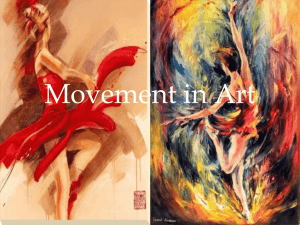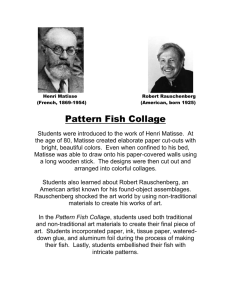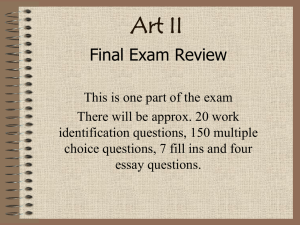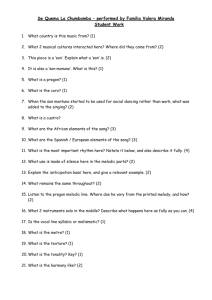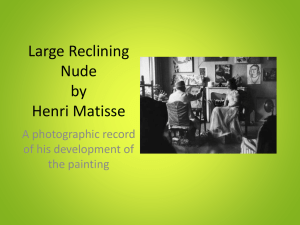Jared C. Sadoian 21M.542 Response III
advertisement
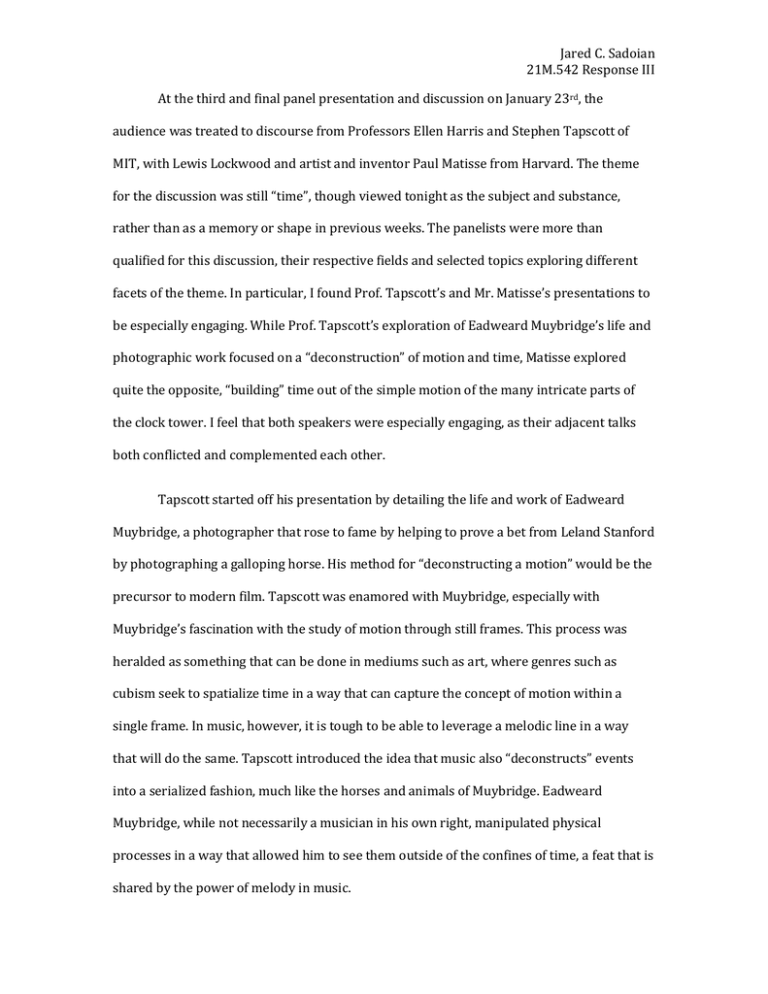
Jared C. Sadoian 21M.542 Response III At the third and final panel presentation and discussion on January 23rd, the audience was treated to discourse from Professors Ellen Harris and Stephen Tapscott of MIT, with Lewis Lockwood and artist and inventor Paul Matisse from Harvard. The theme for the discussion was still “time”, though viewed tonight as the subject and substance, rather than as a memory or shape in previous weeks. The panelists were more than qualified for this discussion, their respective fields and selected topics exploring different facets of the theme. In particular, I found Prof. Tapscott’s and Mr. Matisse’s presentations to be especially engaging. While Prof. Tapscott’s exploration of Eadweard Muybridge’s life and photographic work focused on a “deconstruction” of motion and time, Matisse explored quite the opposite, “building” time out of the simple motion of the many intricate parts of the clock tower. I feel that both speakers were especially engaging, as their adjacent talks both conflicted and complemented each other. Tapscott started off his presentation by detailing the life and work of Eadweard Muybridge, a photographer that rose to fame by helping to prove a bet from Leland Stanford by photographing a galloping horse. His method for “deconstructing a motion” would be the precursor to modern film. Tapscott was enamored with Muybridge, especially with Muybridge’s fascination with the study of motion through still frames. This process was heralded as something that can be done in mediums such as art, where genres such as cubism seek to spatialize time in a way that can capture the concept of motion within a single frame. In music, however, it is tough to be able to leverage a melodic line in a way that will do the same. Tapscott introduced the idea that music also “deconstructs” events into a serialized fashion, much like the horses and animals of Muybridge. Eadweard Muybridge, while not necessarily a musician in his own right, manipulated physical processes in a way that allowed him to see them outside of the confines of time, a feat that is shared by the power of melody in music. Sadoian 2 Paul Matisse, on the other hand, reversed the direction of Tapscott’s presentation, beginning instead with a description and film of the clock tower in the church that he resides. Instead of the separation of the process that Muybridge was so interested in, Matisse expounded on the beauty of “many small parts, many small yet elaborate movements” coming together in a way that produced a completely new movement that would otherwise be impossible to create. In this case, it was the keeping of proper time by the enormous clock tower. Matisse argues that it is in fact music that can bring these “small yet elaborate” movements together in a way to produce something completely new. In fact, music is built off of the interplay between multiple instruments playing together. It is clearest, perhaps, in chamber music, where each instrument has its own part, and it is easy to discern the individual movement of melodic lines within a work to see the relationships that arise. Both Matisse and Tapscott brought their worthwhile contributions to the panel discussion. Neither was wrong, for each made very compelling arguments that effectively backed up their ideas. For Tapscott, the life and work of Muybridge was indicative of a bigger idea that motion that might be too fast for the eye to see can be broken down, deconstructed in a way that will make sense to the viewer. In much the same way, music is a complex motion that is broken down into single melodic lines that can be listened to and digested with greater ease and satisfaction. Matisse, on the other hand, was able to talk about exactly the reverse, the wonder and beauty that can result when many small movements come together to form something new and exciting. Whether it is the many small movements of a clock tower, or multiple solo lines played together in a chamber piece, the result may exceed the sum of its parts. While both presenters were able to tie ideas from their specific fields of interest to the music, their opposite views both provided contrast and complementary ideas to the already dynamic and rich panel experience. Sadoian 3 The concert, similarly to the other two concerts in the series, was built around a survey of music from a wide swath of time, in order to explore the theme of the concert from the differing angles of multiple musical eras. From the 18th century, Mozart’s Oboe Quartet in F major explored early examples of layered time signatures; the 19th century brings Charles Martin Loeffler’s Rhapsodies for Oboe, Viola and Piano, bridging the leap into the 20th century with William Grant Still’s Suite for Violin and Piano and Lukas Foss’s Time Cycle moving into ever-increasing experimental modes of using time as a direct subject of the music. While I thoroughly enjoyed and understood the wonderful simultaneity of the melodic lines in the Mozart, I found that as the concert progressed, I was less engaged as the pieces and music itself devolved into more fragmented ideas and motives and less of a celebration of time as the main subject. The Mozart in particular was excellently played by the quartet. The oboe, a very difficult instrument in its own right to play, delivered crystal clear, melodious lines that carried the piece forward. The oboe was continuously playing notes, only pausing for brief moments to catch a breath as the violin picked up the melody. The most notable part of the Mozart, the layered, differing time signatures between the oboe and the strings, created an exquisitely complex sound out of straightforward Mozartian melodic lines. The piece clearly showed listeners the genius that was Mozart, where in the late 18th century, most pieces were not nearly as deceptively simple yet complex. The work on the whole displayed not only the talent of the ensemble, but an excellent example of the creation of something greater than the sum of its parts, an idea mentioned in the forums earlier in the day. While the concert started off very strongly, Time Cycles, a rather weak choice for an ending, was a tough work to pull apart and fully digest as a listener. The piece was heralded by Prof. Harris at the forum of showing “simultaneity” at its finest, however much of the real Sadoian 4 meat of the piece was lost in a transient slurry of notes from the percussion and piano. The “ringing” of the bells played the piano in isolated, incrementing time signatures was easily lost; I would not have been able to discern them without being informed of them in great detail during the forum. It certainly was not the ensemble’s fault, from the prior pieces played it was clear they were talented. The piece seemed to lack a direction, or focus that made it difficult to process as the performance continued. Perhaps, this might be a case where studying the score and familiarizing oneself with the piece in a visual sense would put some of the more exotic musical ideas into perspective. In its current form, however, it was not very beneficial in demonstrating to listeners the ideas of time as a subject, even though it was named as such. The concert, on the whole, provided an interesting take on the idea of time as a substance or subject of a piece. I found the first two pieces to be gorgeous examples of what one can do with careful control of melodic interplay between parts. The Mozart in particular, out of what seemed very simple at first glance emerged a lovely complexity in the juxtaposition of differing time signatures. I did not, however, find the Time Cycles to be an effective support of the theme of the concert. Being such a difficult piece to characterize and listen to, it became more of a chore to imagine what Foss’s intentions were in the more intricate details of the work. These details were easily lost, and what remained to the audience was a peacefully tumultuous disarray of notes, chords, and percussion. MIT OpenCourseWare http://ocw.mit.edu 21M.542 Interdisciplinary Approaches to Musical Time January IAP 2010 For information about citing these materials or our Terms of Use, visit: http://ocw.mit.edu/terms.
